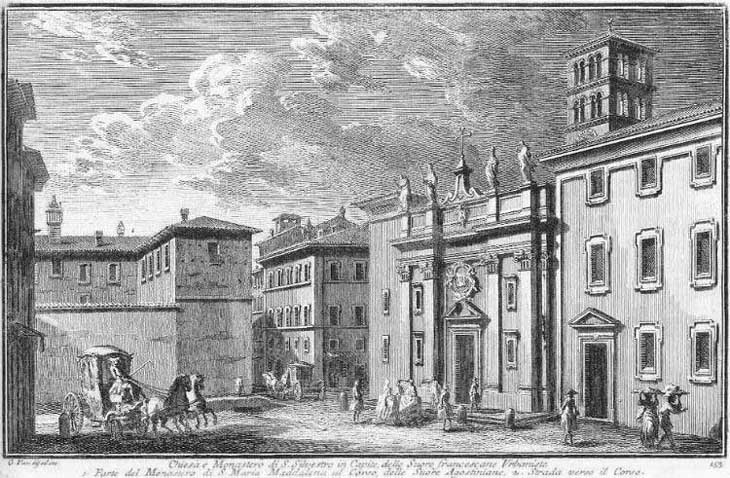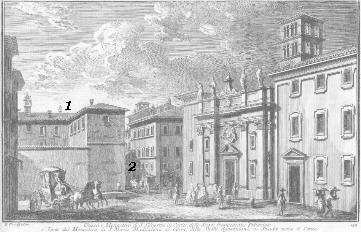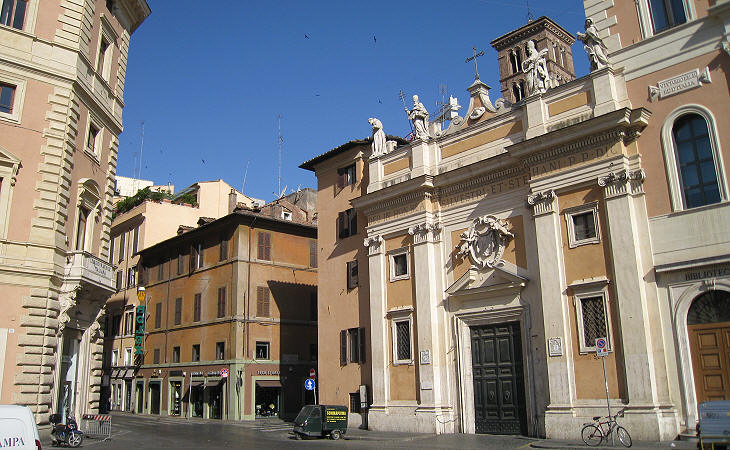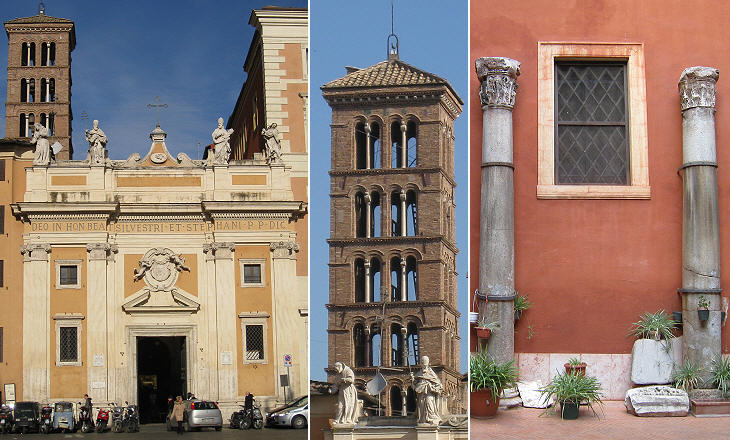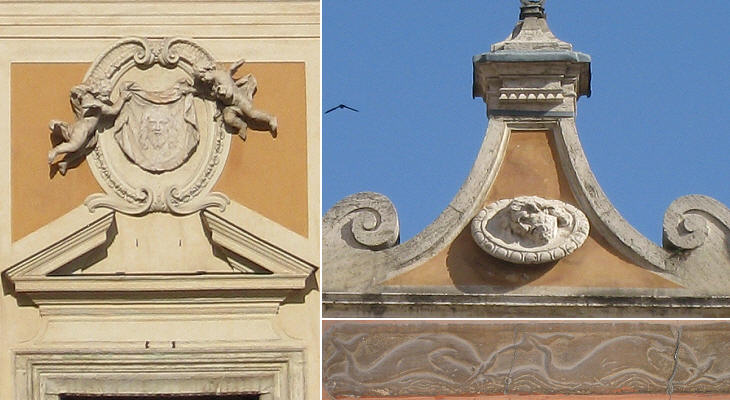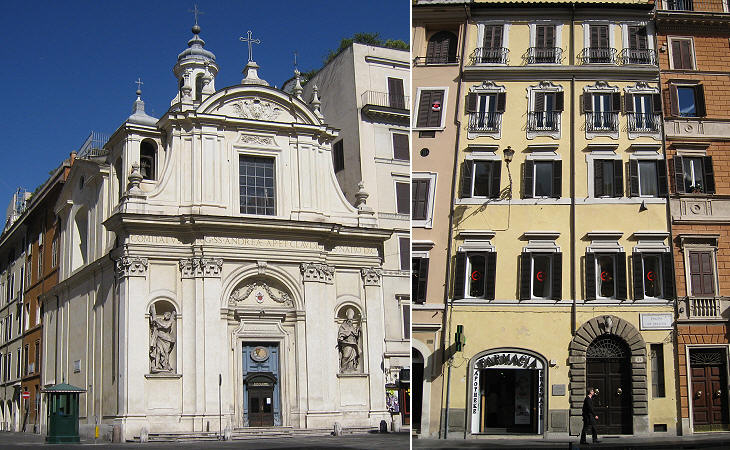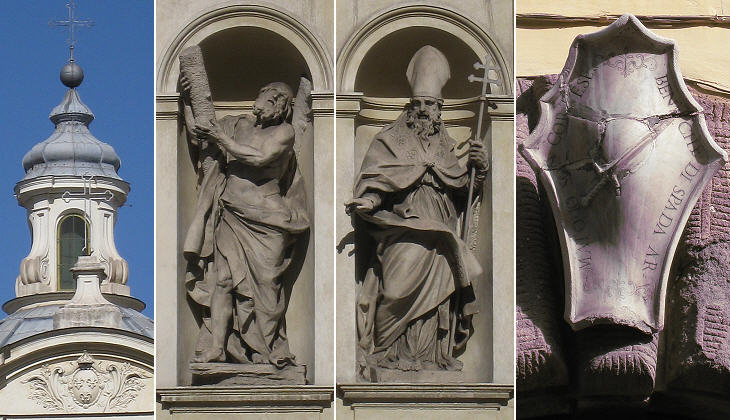  What's New! Detailed Sitemap All images © by Roberto Piperno, owner of the domain. Write to romapip@quipo.it. Text edited by Rosamie Moore. Page revised in January 2010. | Chiesa e Monastero di S. Silvestro in Capite (Book 8) (Map B2) (Day 1) (View C6) (Rione Colonna), (Rione Trevi) and (Rione Campo Marzio)
In this page:
The reference in capite (Lat. caput, capitis head) is generally attributed to the head of St. John the Baptist which has been kept in the church since the XIIth century; it is possible however that it came from the sentence in capita domorum (at the end of the houses), indicating that S. Silvestro was located at the end of the populated part of the city during the Middle Ages and until the early XVIIth century. When Vasi drew his etching the area was fully built and the fašade of the church was renovated in 1703 by Domenico De Rossi (the small coat of arms belongs to Clement XI, the reigning pope at that time). The view is taken from the green dot in the 1748 map below. In the description below the plate Vasi made reference to: 1) Monastery of S. Maria Maddalena; 2) Street leading to il Corso. The small map shows also: 3) S. Silvestro in Capite; 4) S. Claudio dei Borgognoni; 5) Via Borgognona; 6) Casa dei Borgognoni. The dotted line in the small map delineates the borders among Rione Campo Marzio (upper half), Colonna (in the middle) and Rione Trevi (lower end).
Today
At the end of the XIXth century the monastery adjoining the church was transformed into the Central Post Office and today for many Romans S. Silvestro means just the Post Office; the square was enlarged in 1940 by pulling down the buildings between S. Silvestro and S. Claudio dei Borgognoni; it currently houses the terminal of many city bus lines. The monastery of S. Maria Maddalena delle Convertite of which Vasi shows the rear part was pulled down and it is now replaced by Palazzo Marignoli, a modern building in neo-Renaissance style. S. Silvestro in Capite
The church is dedicated to St. Sylvester I, who was pope at the time of Emperor Constantine and to St. Stephen III who was pope in 752-57; it was built by Pope Paul I, St. Stephen's brother on the site of a Temple to the Sun erected in 273 by Emperor Aurelian who promoted that cult in an attempt to strengthen the unity of the Roman Empire. The courtyard houses some ancient columns which have been found by excavating beneath the level of the current church which was entirely renovated after 1593, with the sole exception of the medieval bell tower.
In addition to the head of St. John the Baptist which according to tradition was brought to Rome during the pontificate of Pope Innocent II (1130-43), the church housed the Image of Edessa, a painting portraying the face of Jesus Christ; in 1869 the relic was moved to the Vatican. For more reliefs/paintings portraying the head of St. John visit S. Giovanni Decollato. S. Claudio dei Borgognoni
Bankers and merchants from the Duchy of Burgundy
have lived in Rome since the XVth century. During the Thirty Years' War (1618-1648) and
especially between 1630 and 1642 many
citizens of the Franche ComtÚ (the part of Burgundy which belonged to Spain) sought refuge in Rome.
In 1650 a group of them founded a national brotherhood, which grew in
1678 when another group of refugees came to Rome due to the annexation by France of the
French ComtÚ. The refugees lived between Via del Babuino and Via del Corso
and a street (Via Borgognona) is still named after them. In 1728-1731 the brotherhood built a national church in a small
square near S. Silvestro.
The church was designed by Antoine DÚrizet, a professor at the French Academy in Rome who also designed Santo Nome di Maria (click here for a list of national churches in Rome).
Excerpts from Giuseppe Vasi 1761 Itinerary related to this page:
Next plate in Book 8: Chiesa e Monastero di S. Apollonia Next step in Day 1 itinerary: Piazza Colonna Next step in your tour of Rione Colonna: Palazzo di Propaganda Fide Next step in your tour of Rione Campo Marzio: Chiesa della SS. TrinitÓ Next step in your tour of Rione Trevi: Palazzo Del Bufalo |
